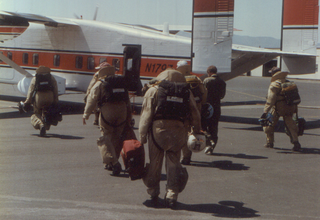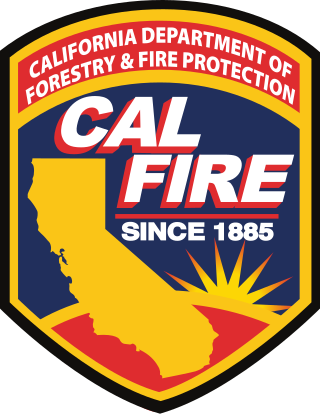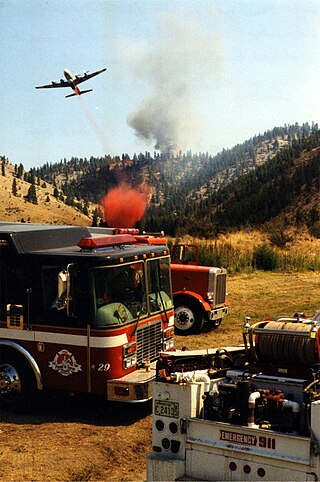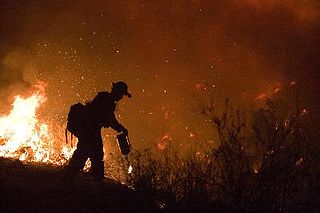
A fire engine, firetruck, or fire ambulance is a vehicle, usually a specially-designed or modified truck, that functions as a firefighting apparatus. The primary purposes of a fire engine include transporting firefighters and water to an incident as well as carrying equipment for firefighting operations in a fire drill. Some fire engines have specialized functions, such as wildfire suppression and aircraft rescue and firefighting, and may also carry equipment for technical rescue.

Smokejumpers are specially trained wildland firefighters who provide an initial attack response on remote wildfires. They are inserted at the site of the fire by parachute. This allows firefighters to access remote fires in their early stages without needing to hike long distances carrying equipment and supplies. Traditional terrestrial crews can use only what they can carry and often require hours and days to reach fire on foot. The benefits of smokejumping include the speed at which firefighters can reach a burn site, the broad range of fires a single crew can reach by aircraft, and the larger equipment payloads that can be delivered to a fire compared to pedestrian crews.

Firefighting is a profession aimed at controlling and extinguishing fire. A person who engages in firefighting is known as a firefighter or fireman. Firefighters typically undergo a high degree of technical training. This involves structural firefighting and wildland firefighting. Specialized training includes aircraft firefighting, shipboard firefighting, aerial firefighting, maritime firefighting, and proximity firefighting.

A helicopter bucket or helibucket is a specialized bucket suspended on a cable carried by a helicopter to deliver water for aerial firefighting. The design of the buckets allows the helicopter to hover over a water source—such as a lake, river, pond, or tank—and lower the bucket into the water to refill it. This allows the helicopter crew to operate the bucket in remote locations without the need to return to a permanent operating base, reducing the time between successive drops.

Aerial firefighting, also known as waterbombing, is the use of aircraft and other aerial resources to combat wildfires. The types of aircraft used include fixed-wing aircraft and helicopters. Smokejumpers and rappellers are also classified as aerial firefighters, delivered to the fire by parachute from a variety of fixed-wing aircraft, or rappelling from helicopters. Chemicals used to fight fires may include water, water enhancers such as foams and gels, and specially formulated fire retardants such as Phos-Chek.

A water tender, sometimes known as a water tanker, is a type of firefighting apparatus that specializes in the transport of water from a water source to a fire scene. Water tenders are capable of drafting water from a stream, lake or hydrant.
Firefighting jargon includes a diverse lexicon of both common and idiosyncratic terms. One problem that exists in trying to create a list such as this is that much of the terminology used by a particular department is specifically defined in their particular standing operating procedures, such that two departments may have completely different terms for the same thing. For example, depending on whom one asks, a safety team may be referred to as a standby, a RIT or RIG or RIC, or a FAST. Furthermore, a department may change a definition within its SOP, such that one year it may be RIT, and the next RIG or RIC.
This glossary of wildfire terms is a list of definitions of terms and concepts relevant to wildfires and wildland firefighting. Except where noted, terms have largely been sourced from a 1998 Fireline Handbook transcribed for a Conflict 21 counter-terrorism studies website by the Air National Guard.

The California Department of Forestry and Fire Protection is the fire department of the California Natural Resources Agency in the U.S. state of California. It is responsible for fire protection in various areas under state responsibility totaling 31 million acres, as well as the administration of the state's private and public forests. In addition, the department provides varied emergency services in 36 of the state's 58 counties via contracts with local governments. The department's current director is Joe Tyler, who was appointed March 4, 2022, by Governor of California Gavin Newsom.

In the United States, a Shot Crew, officially known as an Interagency Hotshot Crew (IHC), is a team of 20-22 elite wildland firefighters that mainly respond to large, high-priority fires across the country and abroad. They are assigned to work the most challenging parts of the fire and are considered strategic and tactical wildland fire experts. Hotshots are a national resource and their deployment is controlled at the national level. Hotshot crews are considered the most highly trained, skilled and experienced wildland firefighters, along with smokejumpers. They are qualified to provide leadership for initial-attack and extended-attack on wildland fires. Hotshots are trained and equipped to work in remote areas for extended periods of time with minimal logistical support. They are organized by agencies such as the United States Forest Service, National Park Service, Bureau of Indian Affairs, Bureau of Land Management, and state/county agencies; the National Interagency Fire Center coordinates hotshot crews on the federal level.

Wildfire suppression is a range of firefighting tactics used to suppress wildfires. Firefighting efforts depend on many factors such as the available fuel, the local atmospheric conditions, the features of the terrain, and the size of the wildfire. Because of this wildfire suppression in wild land areas usually requires different techniques, equipment, and training from the more familiar structure fire fighting found in populated areas. Working in conjunction with specially designed aerial firefighting aircraft, fire engines, tools, firefighting foams, fire retardants, and using various firefighting techniques, wildfire-trained crews work to suppress flames, construct fire lines, and extinguish flames and areas of heat in order to protect resources and natural wilderness. Wildfire suppression also addresses the issues of the wildland–urban interface, where populated areas border with wild land areas.

The National Interagency Fire Center(NIFC) in Boise, Idaho is the American physical facility which is the home to the National Interagency Coordination Center (NICC), and the National Multi-Agency Coordination group (NMAC or MAC).

A wildland fire engine or brush truck is a fire engine specifically designed to assist in fighting wildfires by transporting firefighters to the scene and providing them with access to the fire, along with water or other equipment. There are multiple types of wildfire apparatus which are used in different scenarios. According to the U.S. National Fire Protection Association, if the apparatus will be used primarily for outdoor and wildland responses, then it is to be considered a wildland fire apparatus and must conform to NFPA 1906.
The San Diego Fire-Rescue Department (SDFD) is an all-risk, all-hazards fire department, providing fire protection and emergency medical services to the city of San Diego, California, United States. The San Diego Fire-Rescue Department is the second-largest municipal fire department in the state of California, after Los Angeles and responds to nearly 162,000 calls per year. The San Diego Fire-Rescue Department covers 343 square miles of service area including 17 miles of coastline, with responsibility extending 3 miles offshore.

The CAL FIRE Aviation Management Program is a branch of the California Department of Forestry and Fire Protection. Due to the frequency and severity of wildfires in California, the state has elected to establish its own aerial firefighting force rather than rely solely on contract or national resources. The Aviation Management Program is based at McClellan Airfield near Sacramento, California.

Helitack crews are teams of wildland firefighters who are transported by helicopter to wildfires. Helicopters provide rapid transport, enabling helitack crews to quickly respond and assess a wildfire situation. Helitack crews may land near a wildfire or, if equipped and trained, rappel from a hovering helicopter. Once on the ground, crews build firelines using hand tools, chainsaws, and other firefighting tools. They often remain overnight in remote locations. After they have completed their assignment, crew members may pack up to 120 pounds of equipment over difficult terrain to reach a pick-up point. Rappellers often prepare helispots that provide better access to a fire. Helicopter crew members may also perform other duties such as tree falling, firing operations, and managing helibases.

A Wildland fire module (WFM), formerly fire use module (FUM), is a 7–10 person team of firefighting personnel dedicated to planning, monitoring and starting fires. They may be deployed anywhere in the United States for resource benefits, prescribed fire and hazard fuel reduction projects.

Howard Forest Station is a CAL Fire station and emergency command center (ECC) in Mendocino County, California, located along U.S. Route 101 and 5 miles (8 km) south of the city of Willits. The Howard Forest ECC serves as a secondary public safety answering point (PSAP) for fire and emergency medical services in largely unincorporated Mendocino County. The compound is also the location of the Howard Forest Helitack Base and serves as the headquarters of the Mendocino Ranger Unit.

On August 18, 1937, a lightning strike started the Blackwater Fire in Shoshone National Forest, approximately 35 miles (56 km) west of Cody, Wyoming, United States. Fifteen firefighters were killed by the forest fire when a dry weather front caused the winds to suddenly increase and change direction. The fire quickly spread into dense forest, creating spot fires that trapped some of the firefighters in a firestorm. Nine firefighters died during the fire and six more died shortly thereafter from severe burns and respiratory complications. Another 38 firefighters were injured. The fire killed more professional wildland firefighters in the U.S. than any other in the 103 years between the Great Fire of 1910 and the Yarnell Hill Fire in 2013.

BC Wildfire Service (BCWS) is the wildfire suppression service of the Canadian province of British Columbia. It is an element of the Ministry of Forests, Lands, Natural Resource Operations and Rural Development.



















